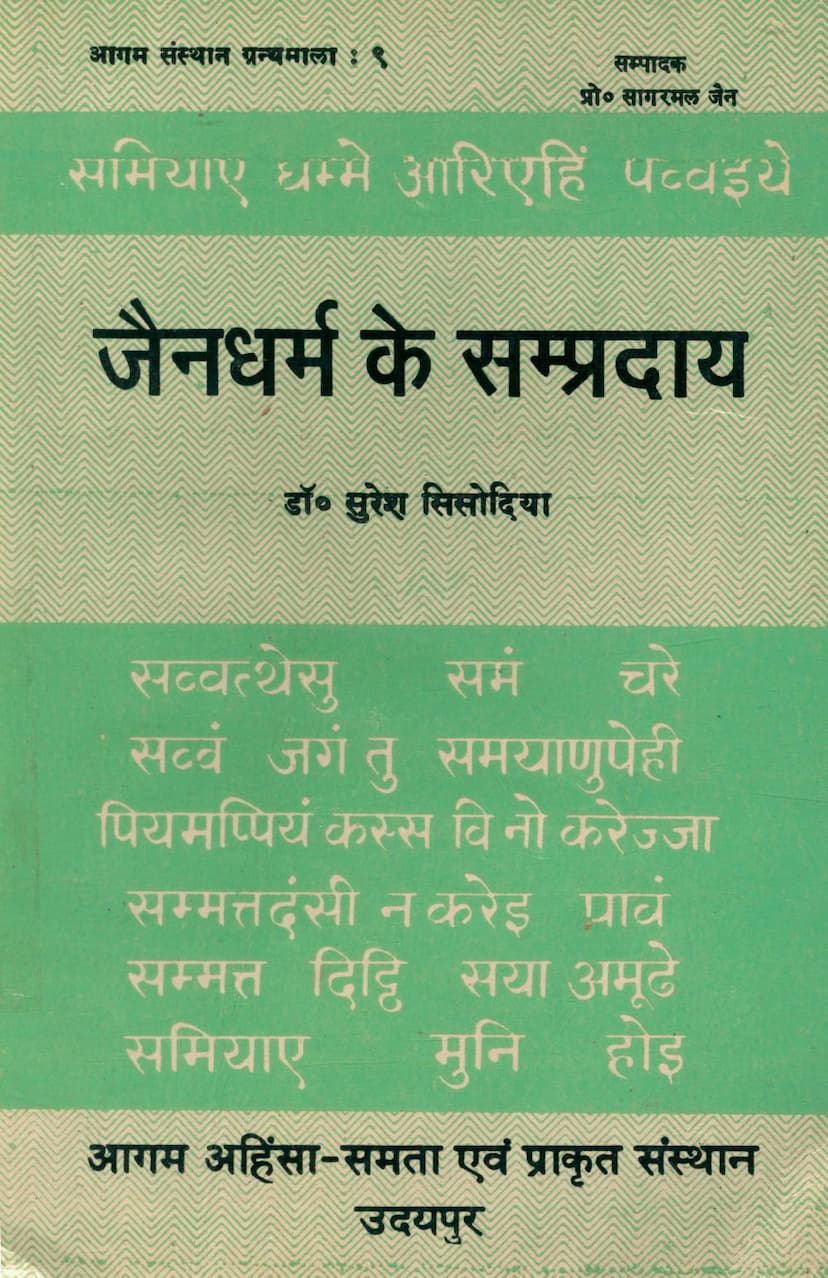Jain Dharm Ke Sampraday
Added to library: September 2, 2025

Summary
Here's a comprehensive summary of the Jain text "Jain Dharm ke Sampraday" by Dr. Suresh Sisodiya, based on the provided pages:
Book Title: Jain Dharm ke Sampraday (The Sects of Jainism) Author: Dr. Suresh Sisodiya Publisher: Agam Ahimsa Samta Evam Prakrit Samsthan, Udaipur Publication Year: 1994 (First Edition)
Core Purpose and Context:
The book aims to provide authentic information about Jainism by exploring its various sects and their beliefs. The publisher emphasizes that communalistic biases often hinder understanding between different Jain traditions, and this book seeks to offer a neutral and insightful perspective. Dr. Sisodiya, a research scholar at the institution, authored this work based on his doctoral research, which was recognized with a Ph.D. by Mohanlal Sukhadia University, Udaipur.
Author's Approach and Structure:
Dr. Sisodiya states his intention to make the book accessible to the general public rather than just scholars. The book is structured into seven chapters:
- Chapter 1: Origin and Development of Jainism: This chapter discusses the traditional and historical perspectives on the emergence and evolution of Jainism, from the first Tirthankara Rishabhadeva to the Nirvana of Mahavir. It also touches upon concepts like the time cycle (Kalachakra) and the era before Tirthankaras.
- Chapter 2: Historical Sources of Jain Sects: This chapter identifies and discusses historical sources used to understand the origin and development of Jain sects, including Jain Agam literature, Jain sculptures, caves and temples, inscriptions, and Jain painting.
- Chapter 3: Sects of Jainism: This chapter introduces the various Jain sects, including Shvetambara, Digambara, and Yapaniya, along with their sub-sects, and analyzes the reasons behind their emergence.
- Chapter 4: Philosophical Beliefs of Different Sects: This chapter delves into the philosophical differences between the sects, focusing on debated points in metaphysics, particularly between the Shvetambara and Digambara traditions. Key topics include the number of tattvas (principles), the nature of time, the laws of pudgala (matter) bonding, the concept of soul, karma, the soul's relation to the universe, the nature of the soul, and the concept of liberation.
- Chapter 5: Ascetic Practices (Shramanachar) of Different Sects: This chapter details the ascetic conduct and practices of the monks and nuns across various Jain traditions, covering aspects like vows, alms-seeking, conduct during the rainy season, permitted possessions, and meditation.
- Chapter 6: Lay Follower Practices (Shravakachar) of Different Sects: This chapter outlines the ethical guidelines and practices for Jain lay followers, including the twelve vows (Anuvratas), subsidiary vows (Guna Vratas and Shiksha Vratas), and the concept of Sallekhana (conscious fasting unto death).
- Chapter 7: Conclusion: This chapter offers concluding remarks and reflections on the overall subject matter.
Key Themes and Content Highlights:
- Ancient Roots: The book emphasizes the ancient origins of Jainism, suggesting its presence even before the Vedic period, citing evidence from the Rigveda and archaeological findings from Mohenjo-daro and Harappa.
- The Concept of Tirthankaras: It explains the role of Tirthankaras as spiritual guides and founders of the Jain community and details the lineage of the 24 Tirthankaras, providing biographical information for Rishabhadeva, Arishtanemi, Parshvanatha, and Mahavir.
- Distinction between Shvetambara and Digambara: The book highlights the fundamental differences between the two main Jain traditions, particularly concerning the acceptance or rejection of clothing for monks (Sachelakatva vs. Acelakatva) and their distinct interpretations of vows, ascetic practices, and philosophical tenets like the possibility of female liberation and the eating habits of Kevalis (omniscient beings).
- The Yapaniya Sect: It brings to light the existence of the "Yapaniya" sect, which existed from the 5th to the 15th century CE. This sect is described as having a unique blend of Digambara ascetic practices (like nudity and carrying a peacock feather whisk) and Shvetambara philosophical beliefs (such as the possibility of female liberation).
- Historical Development of Sects and Sub-sects: The book traces the historical development of various Jain sects and sub-sects (Gachhas), citing numerous inscriptions and literary sources to understand their origins, lineage, and influence over centuries, particularly in Rajasthan.
- Philosophical Debates: It delves into key philosophical debates within Jainism, such as the number of Tattvas (principles), the nature of soul and karma, and the concept of liberation, highlighting the nuances in interpretation between different traditions.
- Ascetic and Lay Practices: The book meticulously details the distinct rules and practices for Jain ascetics (Shramana) and lay followers (Shravaka) across Shvetambara and Digambara traditions, including variations in vows, dietary rules, and the observance of rituals.
- Importance of Historical Sources: Dr. Sisodiya underscores the crucial role of Agam literature, temple sculptures, cave art, inscriptions, and manuscripts in reconstructing the history and understanding the evolution of Jain sects.
Publisher's Contribution:
The Agam Ahimsa Samta Evam Prakrit Samsthan actively supports the publication of Dr. Sisodiya's work, recognizing its academic merit and its contribution to the understanding of Jainism. The publication is also supported by grants, such as the one from Shri Jain Vidyalaya, Calcutta, for their Diamond Jubilee year.
In essence, "Jain Dharm ke Sampraday" is a scholarly yet accessible exploration of the diverse landscape of Jain traditions, offering a historical and philosophical overview of their origins, beliefs, and practices, and serving as a valuable resource for anyone seeking to understand the multifaceted nature of Jainism.